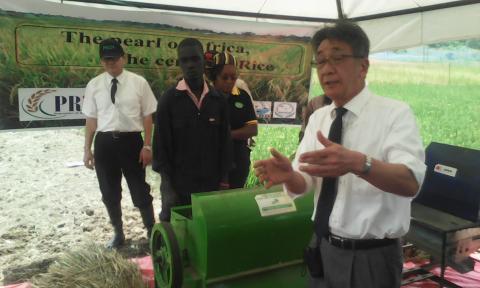Poor mechanisation hindering agricultural transfromation in uganda
Submitted by Christopher Tusiime on

Poor agricultural mechanization is one of the biggest hindrances to transforming Uganda’s agriculture from subsistence agriculture to commercial agriculture, Dr. Godfrey Asea, the Director of National Crops Resources Research Institute (NaCRRI) has said.
Dr. Asea who recently speaking at NaCRRI during a demonstration of agricultural machinery for small scale farmers that have been manufactured in Uganda said 99.4% of small scale farmers in Uganda use traditional, rudimentary and obsolete technologies in agriculture, a major contributor to low farm output.
The machinery including a De–stoner (machines for removing stones from rice), a manually pedaled rice threshers, a manually pedaled water pump which can be used for pumping water for irrigation and a mechanical attachment, an innovation which enables agricultural machinery to be powered using a motorcycle, vehicle or hand tractor are being manufactured with support of Promotion of Rice Development (PRiDe) project.
PRiDe project is being implemented by Japan International Cooperation Agency (JICA), Ministry of Agriculture, Animal Industry and Fisheries (MAAIF), National Agricultural Research Organization (NARO and National Agricultural Advisory Services (NAADS). The project is supporting Uganda to achieve its national rice production targets. The National Rice Development Strategy aims at increasing rice production from 106,700 tons in 2008 to 443,800 tons in 2018.
Asea said demand for rice in Uganda is increasing, a shift that is pushing for more intensive production of rice which produces higher yields from smaller plots.
“We have achieved rice production self-sufficiency. National rice production is 306,000 tons. But increase in population and increasing demand especially in urban areas means new farmers need to be engaged in rice production and those farmers who are already producing rice should adopt better farming methods to increase their rice yields,” he said.
Embassy of Japan’s Deputy Head of Mission, Yutaka Nakamura said efforts of promoting rice in Uganda is paying off as rice production is steadily increasing in the country and making positive impact on the livelihood of farmers in rural areas.
Nakamura said PRiDe project, a five year project – 2011 to 2016 – which set out to increase Uganda’s national rice production by 20,000 tons has surpassed this target, contributing 32,000 tons by December 2015.
Nakamura said Japan has supported 206 projects in Uganda including projects in health, education, water, sanitation, and agriculture with emphasis is being put in integrating agricultural mechanization for small scale farmers in development initiatives.
“Our assistance is in line with the Yokohama Action Plan whose goal is to double rice production in African countries by 2018 through developing capacities to adopt systematic crop management and new methodologies including the wider use of New Rice for Africa (NERICA),” he said.
Nakamura revealed that a storehouse that will prevent farmers from incurring post–harvest loses because of poor storage which makes their farm produce to get spoilt by rain or too much sun is being constructed in Kasese district and post–harvest handling machines are being installed with support from the Embassy of Japan.
Asea said government is promoting the use of cost effective farm tools because the use of machinery will boost agricultural production enabling small scale farmers to produce enough for food and for the market.
JICA Chief Representative, Kyosuke Kawazumi said mechanizing agriculture will encourage young people to get involved in agriculture enabling Uganda to fight unemployment.
“It is good to see Miss Uganda Foundation mobilizing young people to engage in agricultural entrepreneurship. Thanks to the involvement of these brilliant and beautiful young people, we can shed more light on not only rice farming but agriculture as a viable career for young people. I hope that today’s demonstration of agricultural machinery will show that agriculture can be cool, interesting and profitable for the young generation,” Kawazumi said.
He said JICA’s support to the promotion of increased rice production and the development of the rice sector in Uganda which began in 2004 will continue because of its impact to increasing household income and food security especially among rural people.
Kawazumi said Uganda has made remarkable progress in rice production in the past decade and this impact is spreading to neighbouring countries as Uganda has begun exporting rice to the Democratic Republic of Congo and South Sudan.
Miss Uganda Zahara Nakiyaga said, “We are encouraging young people to get involved in rice farming because it is a profitable business. Rice is one of the crops with the highest farm gate price and more people are beginning to eat rice almost every day. There is good market for rice.”
Dr. Kazuhiko Yagi, PRiDe project’s Chief Advisor said broken grains and stones in rice pose a big threat to the demand for rice produced in Uganda.
Yagi said the use of affordable threshing machines will empower small scale farmers to avoid beating rice with sticks in order to thresh it, a practice which causes rice grains to break.
“But importing these machines from abroad makes it very expensive for farmers that is why the project is supporting innovations which enable the machines to be manufactured in Uganda, although some parts like the engine are imported from Japan. This also ensures that spare parts are readily available so the machines are easy to maintain,” he said.
- Log in to post comments
- 3486 reads
